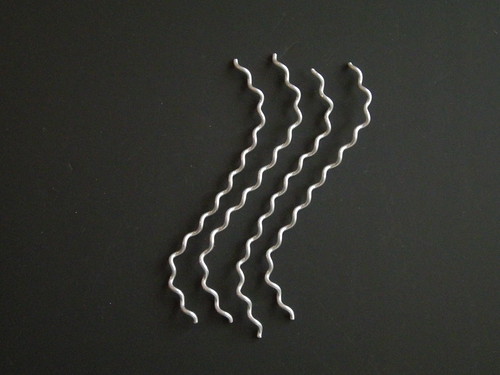These are what I call twongs.
A twong is a helical length of wire that has been bent in four places. Twongs are made by twisting up a pair of wires (these particular ones have been twisted to a helical wavelength of about 5 wire diameters), unravelling them, cutting them to length (these have been cut to a length of 12 helical wavelengths), and then bending. I have been working by hand, so I have been limited to 9 gauge (0.14 inch diameter) steel wire and smaller. Wire is made over a vast range of diameters, so twongs can be almost any size.
The main thing about twongs is that they twine together, three at a time, to form vertices. I've made a video about twining them together. With enough twongs you can make any shape having exclusively 3-valent vertices (three edges meeting at a vertex.) The tetrahedron, cube and dodecahedron are famous 3-valent (i.e., cubic) polyhedra, but there are many more. For example, there are 14,501 isomers of the dodecahedron, that is, different shapes but all with the same number of faces, vertices, and edges as the dodecahedron, and they are likewise all 3-valent. The C-60 buckyball is also all trivalent. Its isomers are effectively uncountable, being in excess of 10 to the 22nd. Yikes!
The are so many cubic polyhedra that, given enough vertices, we can use one to approximate any simple closed (i.e. genus zero) surface. The approximation is never smooth because all lengths are the same, nonetheless, there are many cases where a crinkly surface is a good enough, or where a crinkly surface can be made smooth by some mechanical process. In any case, the alternative--custom cutting every piece (I've tried it)--is a royal headache, and no custom-cut part is ever re-useable.

An astonishing thing about genus zero cubic graphs (let's just toss out the very small number that are non-Hamiltonian) is that they can be identified with words in a language having a very simple grammar. Formally the language is known as the shuffled Dyke language on two types of parentheses. Instead of parentheses we will want to use the following letters:
u, n, d, p
corresponding to (look at them tilting your head to the right) the following twiner's actions
"open left", "open right", "close left", and "close right"
The moves are as follows:
To start, pick up a very first twong and mark it with a twist-tie. This is insurance against getting lost--you can always retrace from the beginning if you know where that is. It also symbolizes that the very first twong is the work in progress. At any later vertex, at least one twong will be already part of the work in progress.
The first letter is always an "open" action, i.e., 'u' or 'n'. In an "open" action you just build a vertex--that's the same for "open left" or "open right." The difference comes when you exit the newly built vertex. To leave a twong "open (on the) left", we must build onto the right twong, Likewise to leave a twong "open (on the) right" we must build onto the left twong. That's all there is to 'u' and 'n,' they just tell us which way to go next.
Close actions require us to incorporate a previously placed twong into the current vertex. According to the letter, we are to look either to the left or the right for this previously placed twong. If there is more than one available on that side we simply choose the nearest one on that side (i.e., most recently placed). This is the same way nested parentheses close, hence the connection to parenthesis languages. Departing a close action is simple since only one of the three twongs will still have a free end.
The last vertex is always a close action. Implicitly, the first twong (the one marked by the twist tie) must be incorporated in this vertex along with the twong indicated by the final letter.
I have more about these "undip" codes in this year's Proceedings of the ISAMA.


No comments:
Post a Comment